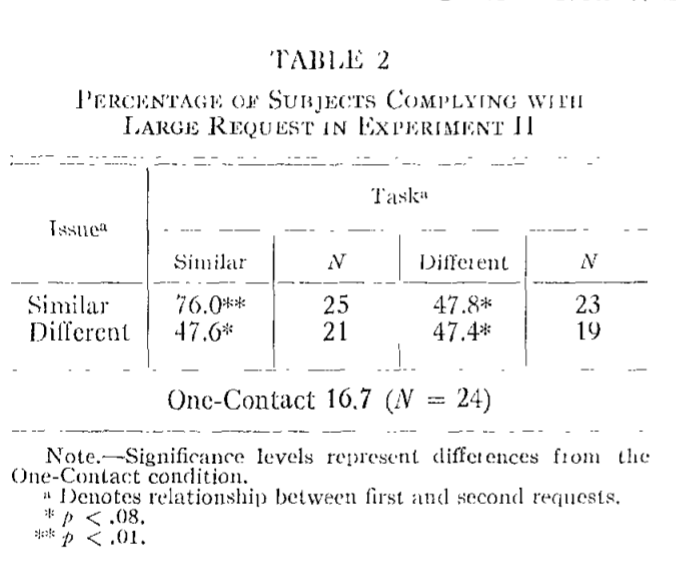The other week as I walked through the mall with my friend, a man standing in front of a shop was offering passer byers some free lotion from his bottle. My friend was slightly hesitant to accept, but evidently thought, “Free lotion, why not?” The man took her hand, looked at it, and said, “Oh my goodness, your hands are so dry! Let me help!” so we entered the shop, following the man. We then spent the next 10 minutes getting free hand massages and trying out different products.
Why did we follow him into this shop when we originally had no intention of entering? The foot in the door technique. This technique involves getting someone to do a smaller task, increasing their chances of later complying to a larger task. By saying yes to taking some free lotion, we eventually said yes to going inside, and in the end, my friend bought a product. Freedman & Fraser studied this technique, calling this approach Compliance Without Pressure; a way to get someone to comply without appearing to be in a position of power (1966). Freedman & Fraser conducted a study in California, asking homeowners to put up a large sign on their front lawn telling people to drive safely. In the experimental condition, the homeowners were previously asked to sign a petition or put up a smaller sign on their property, both related to the topic.


Freedman & Fraser came to the conclusion that 55% of homeowners were willing to put up the large sign if they had signed the petition or put up the smaller sign, compared to the 17% who had no previous interactions regarding the situation. These results were found even when the contact made with homeowners was weeks apart and made by different people.
When my friend and I were done trying different lotions with this man, he asked us if we liked the product, and when my friend said yes, we heard a speech about how there is a sale only today, 50% off with a bonus present. This brings up scarcity, the idea that there is a limited quantity of something (De Sousa et al., 2016). This scarcity, likely a technique used by the salesman, created the thought that we should buy this product now if we wanted a deal.
Why wasn't I pulled in? Probably a few reasons, but the main one that comes to mind is my implementation plan to spend limited money. Implementation intentions are clear instructions on what to do in a specific situation, allowing for an automatic response when in that situation (Gollwitzer et al., 1999). I did this by creating a budget before going to the mall; I gave myself a limit to spend and told myself what I could buy... lotion wasn't on the list.
References
De Sousa, Maysa, Petermna, Amy H., Reeve, Charlie L (2016). An Initial Model of Scarcity. American Psychology Associaion. Vol 5, No. 1, 39-76.
Fraser C., Scott, Freedman L., Jonathan (1966). Compliance Without Pressure: The Foot-In-The Door Technique. Personality and Social Psychology. Vol. 4, No. 2 195 - 202.
Gollwitzer, Peter M., Trotschel, Roman (2007). Implementation intentions and the willful pursuit of prosocial goals in negotiations. Journal of Experimental Social Psychology. Vol. 43.: 579-598.
Why did we follow him into this shop when we originally had no intention of entering? The foot in the door technique. This technique involves getting someone to do a smaller task, increasing their chances of later complying to a larger task. By saying yes to taking some free lotion, we eventually said yes to going inside, and in the end, my friend bought a product. Freedman & Fraser studied this technique, calling this approach Compliance Without Pressure; a way to get someone to comply without appearing to be in a position of power (1966). Freedman & Fraser conducted a study in California, asking homeowners to put up a large sign on their front lawn telling people to drive safely. In the experimental condition, the homeowners were previously asked to sign a petition or put up a smaller sign on their property, both related to the topic.
Freedman & Fraser came to the conclusion that 55% of homeowners were willing to put up the large sign if they had signed the petition or put up the smaller sign, compared to the 17% who had no previous interactions regarding the situation. These results were found even when the contact made with homeowners was weeks apart and made by different people.
When my friend and I were done trying different lotions with this man, he asked us if we liked the product, and when my friend said yes, we heard a speech about how there is a sale only today, 50% off with a bonus present. This brings up scarcity, the idea that there is a limited quantity of something (De Sousa et al., 2016). This scarcity, likely a technique used by the salesman, created the thought that we should buy this product now if we wanted a deal.
Why wasn't I pulled in? Probably a few reasons, but the main one that comes to mind is my implementation plan to spend limited money. Implementation intentions are clear instructions on what to do in a specific situation, allowing for an automatic response when in that situation (Gollwitzer et al., 1999). I did this by creating a budget before going to the mall; I gave myself a limit to spend and told myself what I could buy... lotion wasn't on the list.
References
De Sousa, Maysa, Petermna, Amy H., Reeve, Charlie L (2016). An Initial Model of Scarcity. American Psychology Associaion. Vol 5, No. 1, 39-76.
Fraser C., Scott, Freedman L., Jonathan (1966). Compliance Without Pressure: The Foot-In-The Door Technique. Personality and Social Psychology. Vol. 4, No. 2 195 - 202.
Gollwitzer, Peter M., Trotschel, Roman (2007). Implementation intentions and the willful pursuit of prosocial goals in negotiations. Journal of Experimental Social Psychology. Vol. 43.: 579-598.
.

No comments:
Post a Comment
Note: Only a member of this blog may post a comment.